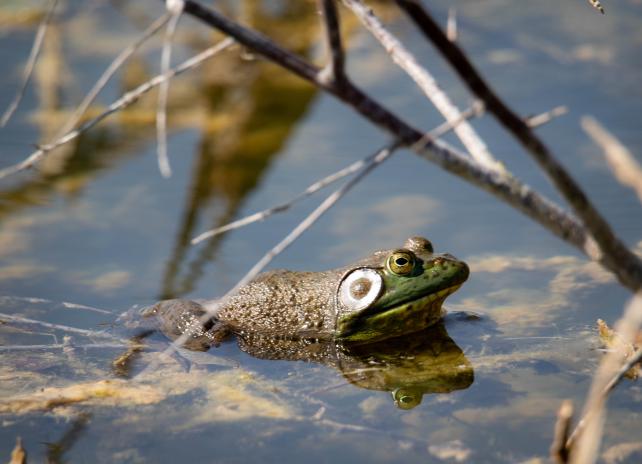Before you get a pet
Before you buy or adopt a pet, consider the size and age the pet may become over its lifetime. Make sure you can accommodate all sizes of your pet and are ready to care for it long-term. Be aware of laws that make certain species illegal to have, such as the Snakehead fish and the Hydrilla plant.
Don't Let It Loose!
Pets can become invasive when owners let them loose. When pets get too large or difficult to keep, some people think letting them loose is the kind thing to do. That's not the case, and releasing them may be illegal. Pets can harm the ecosystem that wild animals depend on, they can cause problems for you and your neighbors and releasing a pet can be cruel to the animal.

Some exotic pets have been released into the wild in Wyoming and have caused harmful impacts to the ecosystem and native species. Learn more about what species are exotic and should not be released into the wild, and what species are illegal to have as pets in Wyoming.
Exotic Amphibian and Fish Pets
Goldfish
Very common pets, goldfish are often released into the wild and have established breeding populations in Wyoming. Goldfish grow much larger when released into the wild than they do in captivity and reproduce quickly, disrupting aquatic ecosystems. They compete with native fish for habitat and resources, and they spread diseases to native fish. The presence of goldfish can cause clear water to turn murky and diminish populations of fish that are fun to catch, such as walleye.
American Bullfrog
Native east of Wyoming, American Bullfrogs are commonly released by schools and pet owners. Unfortunately, bullfrogs have successfully colonized some aquatic areas in Wyoming. They are voracious predators and may eat native reptiles, amphibians, fish, mammals and birds. Bullfrogs can also spread diseases to native amphibians. Bullfrog tadpoles or eggs should also not be released into the wild.
Snakehead
Often bought as aquarium fish for their bright colors, as adults snakehead are aggressive toward other fish and quickly outgrow their tanks. In the wild, snakehead are able to live outside of water for multiple days and travel across land to nearby waters. This voracious fish has been introduced into several U.S. waters and has caused problems for other fishes. Snakehead are illegal to buy or sell in Wyoming.
Exotic Reptile Pets
Red-eared Slider
An aquatic turtle native to southeast and south-central United States, Red-eared Sliders live to 42 years old. Once released into ponds or lakes they compete with native turtles and can transmit diseases and parasites. Several released Red-eared Sliders have been found in Wyoming.
American Alligator
Living 50 years or longer in captivity and growing up to 15 feet long, American Alligators can be difficult pets. If released into the wild, American Alligators may not survive a winter in Wyoming, but they could pose a dangerous threat for humans and native wildlife.
Burmese Python
Many species of python snakes are bought as pets. The Burmese Python has been released into Florida and is now causing largescale damage to the Everglades ecosystem where they prey on threatened and endangered species. The Burmese Python is native to Asia and may grow over 20 feet long and become difficult to care for.
Releasing pets into the wild can irrevocably damage local ecosystems and could potentially cause widespread harm. Released pets may survive and reproduce to form new populations. These new populations can quickly become invasive and are often extremely hard to eradicate from the landscape. Many exotic pets are able to carry disease, and they may introduce pathogens or parasites into the area. Released pets often compete with native species already in the ecosystem for food and other resources, decreasing native populations.
For example, dumping pet fish, such as goldfish, can significantly harm a waterbody. Goldfish are hardy animals and can survive Wyoming winters. They grow and reproduce quickly, outcompete native species for food and root in mud, decreased water clarity and increasing turbulence. Many native fish could die off completely in these conditions, potentially ruining a fishery.
Make sure you know what animals are legal to keep as pets and what plants you can have in your aquarium. Never release a plant or animal into the wild. If your pet gets too much to handle or you need to get rid of your aquarium plants, always remember to C.A.R.E. for them.
WHAT IS C.A.R.E.?
Contact...
the place where you purchased the pet to see if they will take it back.
Act Responsibly...
by never letting animals or plants loose into the wild.
Research...
other places that may be able to provide a new home for your pet. Pet stores, zoos, aquariums, science centers, animal shelters, and humane societies may be able to help.
Euthanize...
the animal in a humane way. It may be hard to consider, but this option is far kinder than letting it starve to death in the wild or destroy the homes of native animals. Always freeze unwanted plants and throw them out in the trash.
Many exotic species are sold as aquarium pets or decoration, and dumping an aquarium in a local pond or stream can release invasive plants, animals and diseases into Wyoming waters. Many of these exotic species outcompete or prey on native species. Releasing a pet can be cruel to the animal as they could starve or freeze to death, be hit by a car or otherwise suffer.
Impacts of dumped aquariums have already been felt in Wyoming. Established goldfish populations have been found in various waters, disrupting the ecosystem and harming native and sport fishes. Goldfish compete with native species for habitat and resources, reproduce quickly, and are known to be disease carriers that affect bass, trout, and other native species. These goldfish populations likely exist because someone dumped their aquarium pet. Help keep invasive species out of Wyoming waters by properly getting rid of your aquarium through rehoming your pets or correctly disposing of aquarium contents.
How to properly dispose of an aquarium:
- Remove any pets from the water and tank.
- Remove all plants, rocks, decorations and any water from the aquarium and put them into a heat-safe pot. Do not dispose of any water down the drain or toilet.
- Boil the plants, rocks, decorations and water for at least five minutes.
- Remove the plants from the pot, securely bag them and throw the bag in the garbage. Do not compost aquatic plants or throw them into your yard as rain or other forces could wash these plants or their seeds into nearby waterways or ditches. For some species it only takes one small plant fragment making it to a waterway to establish a population.
- Remove the rocks and decorations and allow them to dry completely before reuse or disposal.
- Pour out the boiled water on a semi-permeable surface. That could be a houseplant or outside — like grass or soil — that is not located near standing water or a storm drain.
- Disinfect the aquarium using bleach or other cleaning solution.
- Allow the aquarium to dry completely.

